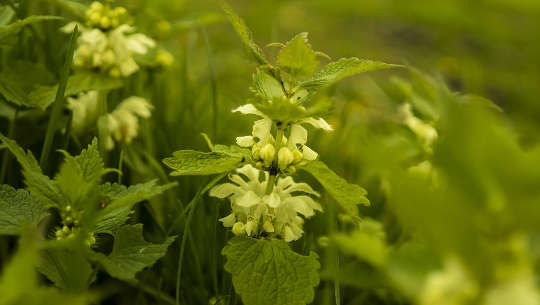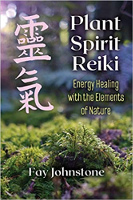
Stinging nettle plant in bloom. Image by FelixMittermeier
Narrated by Marie T. Russell.
Editor's Note: If you are not a Reiki practitioner, or are not familiar with Reiki. you can substitute the words "healing energy" or "the energy of Love" for the word Reiki, as you read.
As an herbalist I have a very different view of weeds than the average gardener who can’t abide common garden weeds such as nettle, dandelion and plantain. These plants and many more of our garden weeds are nutritious and full of minerals and beneficial medicinal properties. When you view plants in this way it can make weeding extremely challenging and full of guilt.
As much as I love my garden weeds for their medicinal uses, though, I do pull them up sometimes as I also enjoy looking at a flower bed that is nettle-free! I always talk to the plants as I am weeding, asking them to politely grow elsewhere. I often explain why I am pulling them up. It’s usually to give another plant space or light to grow.
To make the process a little easier I like to work in my garden using reiki as well as Ho’oponopono, the Hawaiian practice for forgiveness that translates as “moving from darkness to light”. The practice of Ho’oponopono is based on the understanding that we are all connected and that by taking responsibility for the suffering of others we can bring about transformation and healing. It is a cleansing practice that requires an ability to be humble and to love unconditionally.
This simple prayer of Ho’oponopono comes in very handy when you are weeding, pruning, thinning, transplanting and harvesting plants. I also find it useful when I am harvesting food or flowers from the garden.
The prayer helps me ask for forgiveness and also removes any guilt I may feel about harvesting from the plant, as I take responsibility for my actions.
The prayer goes like this:
I am sorry
Please forgive me
I love you
Thank you
To understand this prayer you could think of it like this:
I am sorry for anything that I or my fellow human beings are doing to cause you (or your family/home) suffering.
Please forgive all of us.
I see the divine in you and I love you.
Thank you for all that you are teaching me.
Guidelines When Meeting a Plant
Whenever you are interacting with plants, planting, weeding, harvesting or just admiring as you take a walk outside in nature, treat a plant as you would a person. Introduce yourself, make conversation, explain what you are doing and be respectful.
The following may act as helpful pointers. Most importantly, feel into your heart space for what is appropriate.
1. Introduce yourself, e.g., “Hello, my name is Fay.”
2. Show appreciation to the plant, e.g., “It’s great to meet you, you look radiant.”
3. Present an offering or offer reiki.
4. State your intention. “I would like to get to know you better”, or “I would like to harvest some of your leaves to make an infused oil at home to help heal my skin.” Or if gardening, “I am going to trim some of your branches to give the other plants more light.”
5. Spend as much time with the plant as you need to feel into the space between you. You might simply breathe with the plant, observe how it grows, sense its energy field, open up all your senses and feel your way.
6. Connect to the plant with reiki and really let the plant into your heart, visualize it there and love it. You might like to sit in gassho (placing your two hands together as in prayer or homage) and tune in to reiki, asking it to flow to help you connect with the plant. Open your intuition and let it guide you to show you the energy of the plant.
7. Always ask permission to touch, taste and smell the plant—if it doesn’t feel right then don’t do it! Use your common sense where taste is concerned. Don’t nibble on plants that you cannot identify as being non-poisonous. If you do feel called to taste the plant then place a small amount on your tongue and chew—if it feels prickly or odd then SPIT IT OUT!
8. Always give thanks and leave the plant and the area as untouched as it was when you first arrived.
9. Consider ways that you could interact with the plant further. What does the plant inspire in you? Would the plant benefit from more reiki or something else that you can do?
Tuning In to the Energy of a Plant
Plants with diseases may need individual care and attention, so it’s worth tuning in to each of these plants as necessary. If this seems a little daunting, why not approach the plant as if it were a client?
If you notice that a particular plant does not seem to be doing very well, it may benefit from reiki. Depending on the size or accessibility of the plant, you can choose to give hands-on reiki by physically touching the trunk, branch, stem or leaves, or send reiki at a distance.
Sit yourself next to the plant in question, get comfortable and introduce yourself (though it probably knows exactly who you are anyway!). Explain to the plant that it doesn’t look as happy or as vibrant as you have often seen it. Explain that you would like to offer it some unconditional love in the form of reiki and feel for a response.
What you are looking for is a good feeling, a peaceful feeling that feels like your heart is opening. If your heart feels uncomfortable or contracted then I would leave this plant alone for today and go and find another. You can always come back to a plant at another time.
Know that the plant is not going to greet you as a client would and explain what ails them, so you will need to spend some time tuning in to the plant’s frequency and observing the plant as it grows.
Once you have a feeling that the plant is happy to work with you, prepare yourself and connect with reiki in the way that you would if you were working with a physical client. Tune in to the plant, breathe with it. Know that as you breathe, you are breathing in oxygen that is produced by the plant and as you exhale, you are breathing out carbon dioxide that is needed by the plant to perform all its vital growth functions.
Breathe together for about five minutes and attune your physical senses to the state of the plant. Observe how this plant looks: does it look healthy, is it struggling, stunted, dry, waterlogged, diseased or bug-eaten? Tune in; think—if it was a client what would their appearance tell you about the state of its health?
Trust your first response and ask yourself, “What does this plant need right now, how can I help?”
Feel the energy field of the plant by moving your hands slowly through the space around the plant. This might be very near or several feet away depending on the size of the plant and its specific vibration.
Invite reiki to flow through you and sense the plant’s energy field with your hands. This will be easier with certain plants than with others. Start a distance away with your hands held out, just as you would start to sense energy with a person or animal, and keep moving yourself and your hands closer until you sense the energy of the plant.
You may find that plants like large trees have a huge energy field that you can sense way before you get close enough to touch them. Smaller herbs and potted plants will have a smaller energy field and your hands may come much closer to the plant, even as little as a few centimetres away. You will be able to feel how strong it feels.
Notice what sensations you are feeling in your hands and your body or what emotions are being triggered. You might find it similar to working with a human or animal, or it might feel quite different.
Feel for the way that you work with energy and the way that you receive and intuit information.
Open your intuitive senses. Ask yourself the question: how healthy is the plant? To give yourself something to compare later, give this on a scale of 1 to 10, with 10 being maximum health and vitality.
©2020 by Fay Johnstone. All Rights Reserved.
Publisher: Findhorn Press, an imprint of
Inner Traditions Intl. www.innertraditions.com
Article Source
Plant Spirit Reiki: Energy Healing with the Elements of Nature
by Fay Johnstone.
 In this practical workbook, Fay Johnstone demonstrates how energy healers and Reiki practitioners can partner with plant spirit allies and the forces of nature for powerful healing for themselves, others, and our planet. She explains how to include plants and nature in your Reiki practice, both the spiritual/etheric components of plants and the physical plants themselves. She offers many practical exercises, techniques, and meditations as well as case studies and personal experiences to show how best to harness the power of plants on all levels, along with other energy flows, to support the healing process in much the same way that crystals are used as energetic healing aids. She explains how plants connect with the Reiki principles and explores plant spirit allies, chakra work, and healing with the elements of nature. She details how to enhance self-healing and Reiki treatments for others through “bringing the outside in,” creating a healing space, use of plant preparations, and other sacred forms of plant medicine.
In this practical workbook, Fay Johnstone demonstrates how energy healers and Reiki practitioners can partner with plant spirit allies and the forces of nature for powerful healing for themselves, others, and our planet. She explains how to include plants and nature in your Reiki practice, both the spiritual/etheric components of plants and the physical plants themselves. She offers many practical exercises, techniques, and meditations as well as case studies and personal experiences to show how best to harness the power of plants on all levels, along with other energy flows, to support the healing process in much the same way that crystals are used as energetic healing aids. She explains how plants connect with the Reiki principles and explores plant spirit allies, chakra work, and healing with the elements of nature. She details how to enhance self-healing and Reiki treatments for others through “bringing the outside in,” creating a healing space, use of plant preparations, and other sacred forms of plant medicine.
Click here for more info and/or to order this book. Also available as a Kindle edition.
About the Author
 Fay Johnstone is passionate about plants and people and draws on her experience as a former owner of a flower and herb farm and her shamanic training to assist personal transformation with the subtle whispers of nature. Fay teaches workshops on plant spirit connection, Earth based healing and offers shamanic treatments across the UK, online, and from her home near Edinburgh, Scotland.
Fay Johnstone is passionate about plants and people and draws on her experience as a former owner of a flower and herb farm and her shamanic training to assist personal transformation with the subtle whispers of nature. Fay teaches workshops on plant spirit connection, Earth based healing and offers shamanic treatments across the UK, online, and from her home near Edinburgh, Scotland.
Visit her website at http://fayjohnstone.com




























